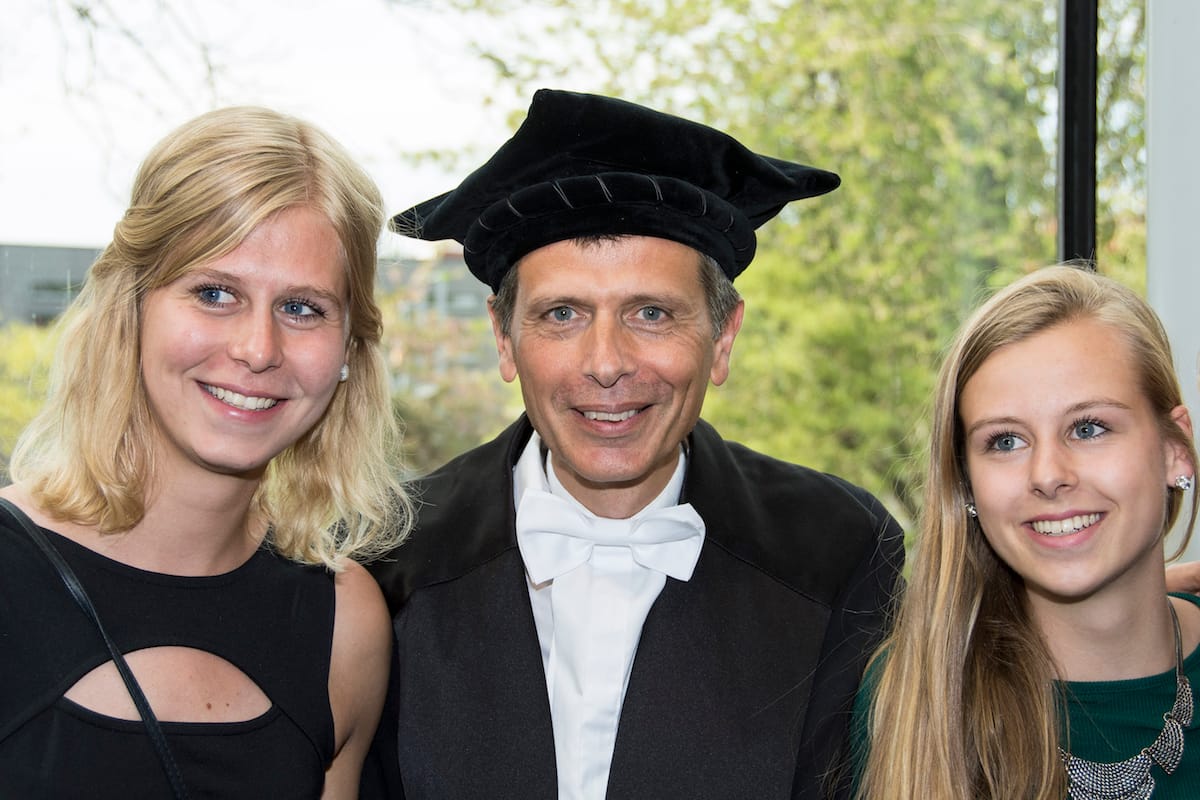
Fast on track: Interview with Dick de Waard

When I entered a well-structured office, containing a packed toga and traffic board on the wall, I knew I was at the right spot: an interview with a young professor in Traffic Psychology, Dick de Waard (1964). Throughout his career Dick has always been interested in traffic and applied research in this context. In the last 10 years, he also became very motivated to extend mobility of older adults. These interests provided him with experience in both the fundamental and applied fields of Traffic Psychology. Technological advancements to move safely by car or bike are expanding, but the applicability of these advancements in daily life still requires a lot of scientific insights from Traffic Psychology to be translated towards effective and safe interventions. Recently, Dick became a professor of ‘Traffic Psychology and the Retention of Mobility’ in the Department of Clinical and Developmental Neuropsychology of the faculty of Behavioural and Social Sciences of the University of Groningen (RUG), and on May 10th 2016, he gave his inaugural lecture. I talked to him about the opportunities and challenges that he experienced on his move towards professorship.
“I never intended to write a PhD thesis and become a professor.”
The road to professorship
Dick’s main research interest has been, and still is, the measurement of driver mental workload. It was also the topic of his PhD thesis (University of Groningen (RUG), 1996). Actually, he never specifically intended to write a PhD thesis, but he enjoyed working at the university, where a PhD was very useful if not required. After his PhD, Dick continued working as a research fellow at the RUG, combined with a brief freelance position at ITS Advies, a scientific research and consultancy company in the area of Intelligent Transport Systems (ITS), and part-time employment at the Faculty of Technology, Policy, and Management at Delft University of Technology. As a result of his growing knowledge and expertise on mobility, he began a Tenure Track position at the RUG in 2009. That position now resulted in his professorship. Dick really values working at the RUG and living in the northern Netherlands, because of, amongst other reasons, the nice colleagues and outstanding opportunities for collaborations.
Information processing in the real and virtual traffic environment
Drivers’ inadequate (either too low or too high) mental workload may lead to imperfect perception, insufficient attention and inadequate information processing. In the past years, Dick has been active in the applied fields of information processing in the traffic environment. Study topics have included the detection of impaired driving, behavioural effects of advanced driver assistance systems, and driver training. These studies were carried out in both real and virtual traffic environments, which allow for empirical and controlled behavioural observations. Empirical research requires flexible adaptations of the researcher to real life situations. When observing behaviour, you cannot control weather conditions, where cars park, and how many individuals will pass your observation spot. Dealing with these uncertainties is what fascinates Dick; it‘s one of the skills that he likes to pass on to students.
According to Dick, observing how car drivers behave ‘in the wild‘ is just as important as studying their behaviour in a driving simulator to understanding driving behaviour. For example, Dick investigated mobile phone use while riding a bicycle. Whereas cyclists were mainly calling in 2008, he observed a shift towards screen operation such as texting in 2012. After the first observation, he also performed controlled experiments, such as having participants ride their own bicycle that had been instrumented with a GPS to measure speed while they performed tasks on a mobile phone. They had to type text messages or listen to music. The ethical committee required that these tests were performed on a quiet isolated cycle path, which was somewhat artificial. However, taken together, the observations and controlled experiments give a good overview of the prevalence and effects of phone use on cycling behaviour. The most remarkable observation was that cyclists who are operating their phone increase their safety margins and keep more distance from the curb. You can also observe this in real life; in general, when someone rides far from the curb, they are usually on their phone!
“I enjoy working at the university and contributing to the retention of mobility through applied science.”
Besides behavioural observations in real traffic environments, Dick investigates mental workload in a driving simulator using physiological measures such as brain activity and heart rate. A driving simulator is a suitable research environment to study mental workload because it‘s safe, flexible, and allows for good control of specific traffic situations. One example of a task used in the driving simulator is the Gap Acceptance Task. Using this task, the researcher can investigate a driver‘s perception of the gap sizes in a moving stream of traffic and the fine coordination mechanisms to synchronize the onset of movement with the approaching gap. Understanding how drivers decide that a gap is crossable, and how they time their crossing in relation to a moving stream of traffic, is critical for understanding how people make decisions on higher levels and the risks they accept. Studies by Brookhuis and De Waard using the Gap Acceptance Task have shown that after the use of the recreational drug MDMA (ecstasy), low-level control remained intact (people do not start swerving, for example). However, those drivers did accept smaller gaps, which reflects increased risk acceptance.
Besides studying the effects of drug use on driving performance, Dick also studies the mobility issues of older adults with and without mild cognitive impairment or dementia. Losing mobility has severe effects on people’s well-being, and very often people can retain mobility and drive safely, even with mild cognitive impairments (MCI). To evaluate fitness to drive, only an on-the-road test under supervision of a CBR driving examiner could be used in the past. Dick and his colleagues are now working on a battery of neuropsychological tests, in combination with heteroanamnesis and a ride in the simulator, to filter out those who do not need the on-the-road test, i.e. people who perform very well and very badly. A validation study showed that over 95% of the predictions of fitness to drive on the basis of test battery, heteroanamnesis, and simulator ride coincide with the outcome of the evaluation of the examiner of the on-the-road test that followed these tests.
Moving abroad – a requirement to become a professor?
Paradoxically for a professor of Traffic Psychology, Dick feels ‘moving abroad’ is a bit overrated with respect to its effect on academic promotion, in particular, if people do not see much more than the four walls of a lab while abroad. However, he values the advantage of international collaborations, for example in European projects. Working with experts from different countries in and outside Europe provides him with an extensive network. For example, Dick collaborates with researchers from JARI, Japan Automobile Research Institute. Together, they have performed studies on the accidents that are common in the rice fields: two cars on a collision course that can see each other but still collide because no motion is detected, as the angle of perception remains constant. In Japan this is a serious problem! They also considered solutions, first evaluated in the simulator and later on site: blocking the view at intervals in order to let vehicles “pop up”. This turned out to be a simple and effective solution. Notwithstanding ample difficulties in written and verbal communication, it is the mutual interest in Traffic Psychology that binds individuals from all over the world. Apart from international European projects, Dick has coordinated and contributed to national projects. For example, the Traffic Psychology staff works together and has close contacts with TNO Human Factors, NLR Dutch aerospace, Visio, and several engineering consultancies. Altogether, (inter)national collaborations, instead of working abroad for a longer period of time, provided Dick with relevant experience and expertise to become a professor.
The future of Traffic Psychology
Dick is most inspired by colleagues who are optimistic and possess the ability to look for opportunities. While moving along the academic ladder, it became more important to use these capabilities not only to develop himself, but also to guide a team of researchers and other collaborators towards a better understanding of drivers’ mental workload. Recently, a new master programme named ‘Traffic Psychology and Sustained Mobility‘ was launched at the Faculty of Behavioural and Social Sciences, to make new students develop into experts in the applied and research field. In the Netherlands, this master programme is unique to the University of Groningen. As technology advances, real-life usage of technological advancement ultimately depends on the response of drivers. For this reason, understanding information processing in traffic environments is essential. We hope to hear more about the work of Dick de Waard soon.



